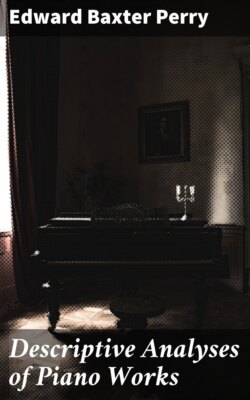Читать книгу Descriptive Analyses of Piano Works - Edward Baxter Perry - Страница 10
Beethoven: Sonata in D Minor, Op. 31, No. 2
ОглавлениеThis is not usually considered a descriptive composition, but Beethoven, when questioned regarding it, answered: “Read Shakespeare’s ‘Tempest.’” With this hint from the most authoritative of all sources, the composer himself, we may easily trace, if not a strongly realistic, at least a suggestive reference in the music to that most romantic drama by the greatest of English play-writers. And we may also find a pertinent rebuke for those who are inclined to sneer at the idea of descriptive suggestion in music in general and in Beethoven’s works in particular, in spite of Beethoven’s own words: “I always have some picture in mind when I write.”
The first movement of this sonata opens with an extremely simple theme, consisting merely of the notes of the common triad—do-mi-sol-do—a theme so bald, so apparently devoid of beauty and latent resources that only Beethoven would have ventured to use it; and only his genius could have given it any degree of interest. It is evidently chosen with deliberate intention to indicate naïve simplicity and natural primitive conditions of life in the island, as Prospero found it, with that half-animal, half-savage man, Caliban, as the most prominent figure in it. His singular, ludicrously grotesque personality may have suggested some of the clumsily rollicking passages in this movement. The tempest is only hinted at, not vividly portrayed—a tempest in miniature, a storm in fairyland. Still, it is unmistakable, though divested of all its terrors, just as it must have appeared to Prospero himself, whose magic power and complete mastery over the elemental forces placed him above and beyond all fear.
The second movement, full of sweet repose, of grave, tranquil happiness, is like the hearts of the two lovers in the drama, safe in the loving and powerful protection of Prospero, living close to the gentle, passionless breast of Mother Nature, childlike in their simple trust, their spontaneous affection, their simple joy in the passing hour. It seems at first rather tame and colorless to our modern ears, accustomed to the ceaseless stress and din of complex and conflicting elements, warring together in the life and art of our own day; but if we can forget for a moment the intensity, the restless questioning and striving of the present and go back in spirit for a century or two to more normal conditions, we shall find this music restful and soothing as the green sweep of woods and meadows on a June morning in the country, after the glare and fever of a city ball-room.
The closing movement, with its light, tripping rhythm, its playful, half-facetious mood, is evidently intended to recall the pranks of that merry, tricksy sprite, Puck, so brimming over with good-natured fun and laughing mischief, yet so ready and able, at his master’s command, to “put a girdle round the world in forty minutes.”
The whole is a work of delicate fancy rather than emotional depth or dramatic force. It shows us a somewhat unusual phase of Beethoven’s genius, and is but one more proof of his versatility, one more justification for his title, “The Shakespeare of Music.”
